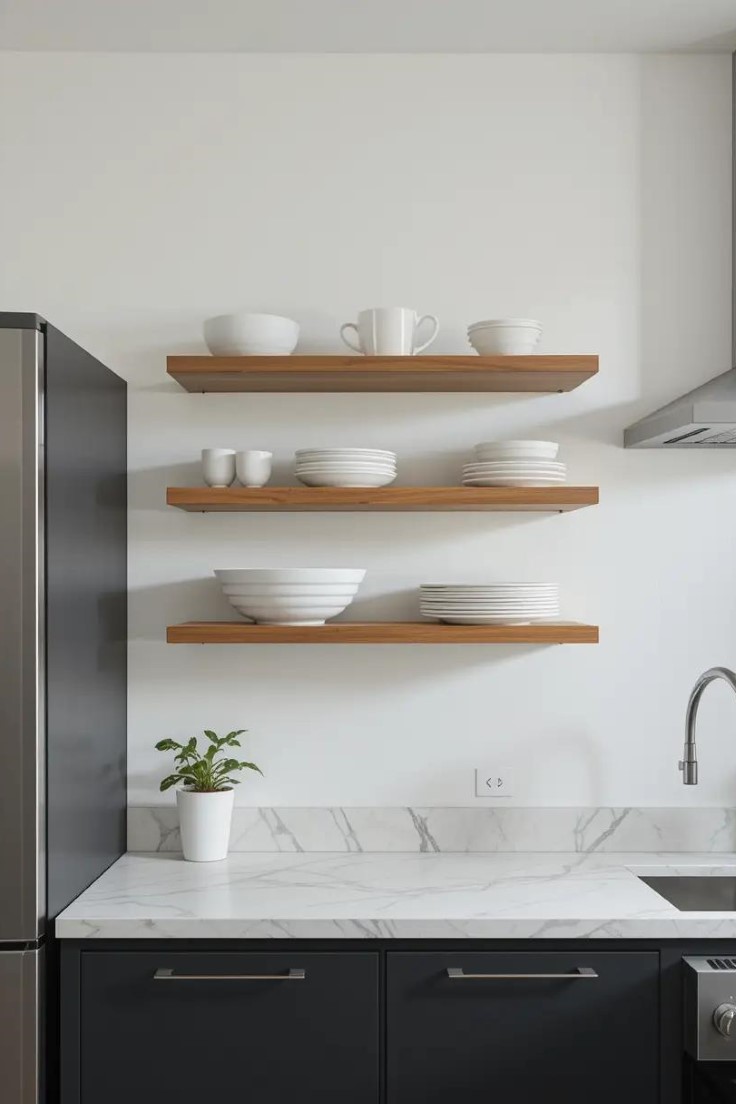This site contains affiliate links, view the disclosure for more information.
Are you looking to declutter your space while still showcasing your favorite items? Floating shelves offer the perfect solution for creating storage that feels light, airy, and intentional. These wall-mounted wonders appear to “float” against your walls without visible brackets, making them ideal companions for minimalist design.
In this guide, we’ll explore 17 creative floating shelves ideas that embrace minimalism while maximizing both function and style. Whether you’re redesigning your living room, bedroom, kitchen, or bathroom, these ideas will help you create streamlined storage that complements your clean aesthetic.
Why Floating Shelves Work for Minimalist Spaces
Before diving into specific ideas, let’s understand why floating shelving and minimalism make such perfect partners:
- Floating shelves eliminate visual clutter by removing bulky supports and hardware from view.
- They create useful storage without overwhelming your walls.
- The clean lines complement minimalist principles of simplicity and purpose.
- They force intentional decorating since limited space means selecting only what matters most.
Now, let’s explore 20 ways to incorporate floating shelving into your minimalist home design:
Living Room Floating Shelves Ideas
1. Single Long Floating Shelf
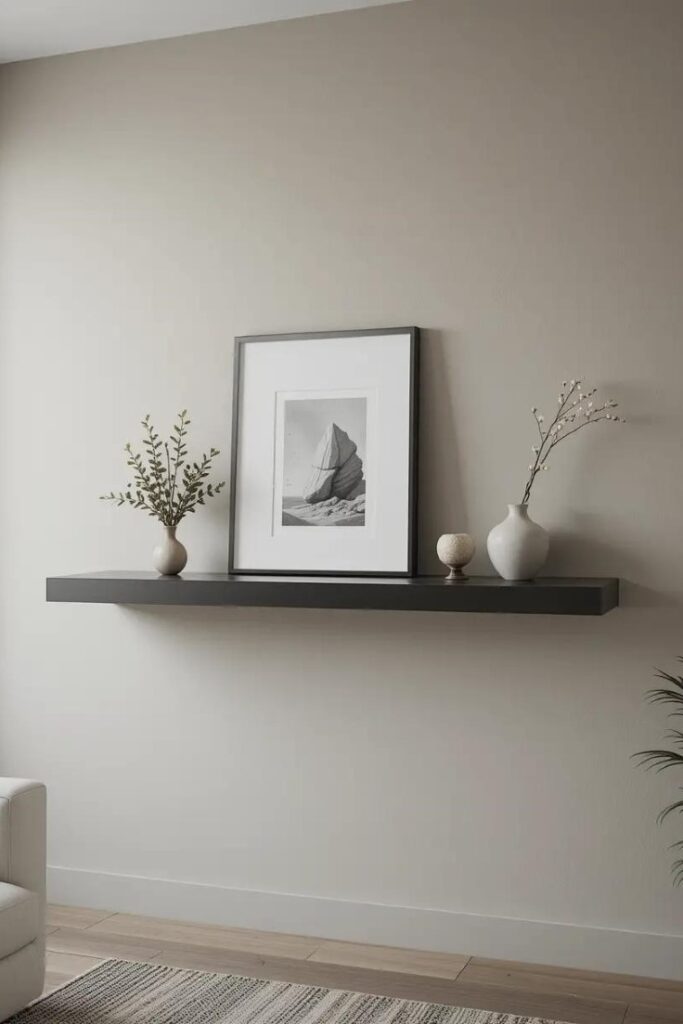
For the ultimate in minimalist design, install one extended floating shelf along a focal wall. This creates a sleek horizontal line that can hold a few carefully selected items. The beauty of a single shelf lies in its restraint—it provides just enough display space without overwhelming the wall. Choose a shelf in either a matching wall color for a seamless look or in contrasting wood for gentle warmth.
2. Asymmetrical Arrangement
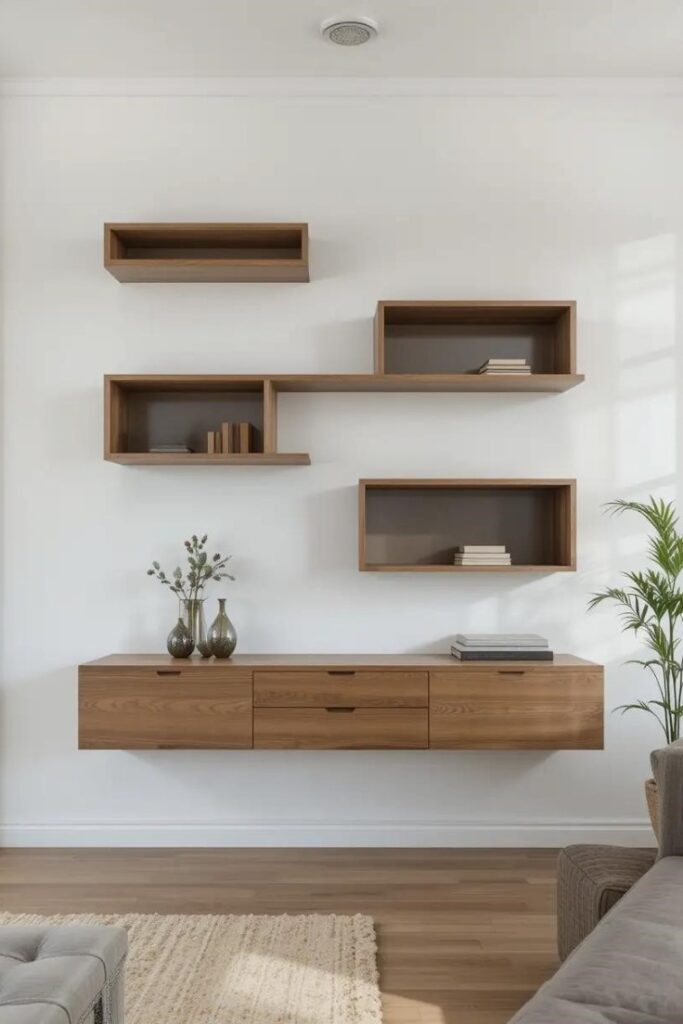
Break from the expected by installing floating shelves in an intentionally uneven pattern. Vary the lengths and positioning while maintaining enough negative space between them. This creates visual interest while staying true to minimalist principles. Asymmetrical arrangements feel modern and thoughtful when executed with restraint.
3. Corner Floating Shelving
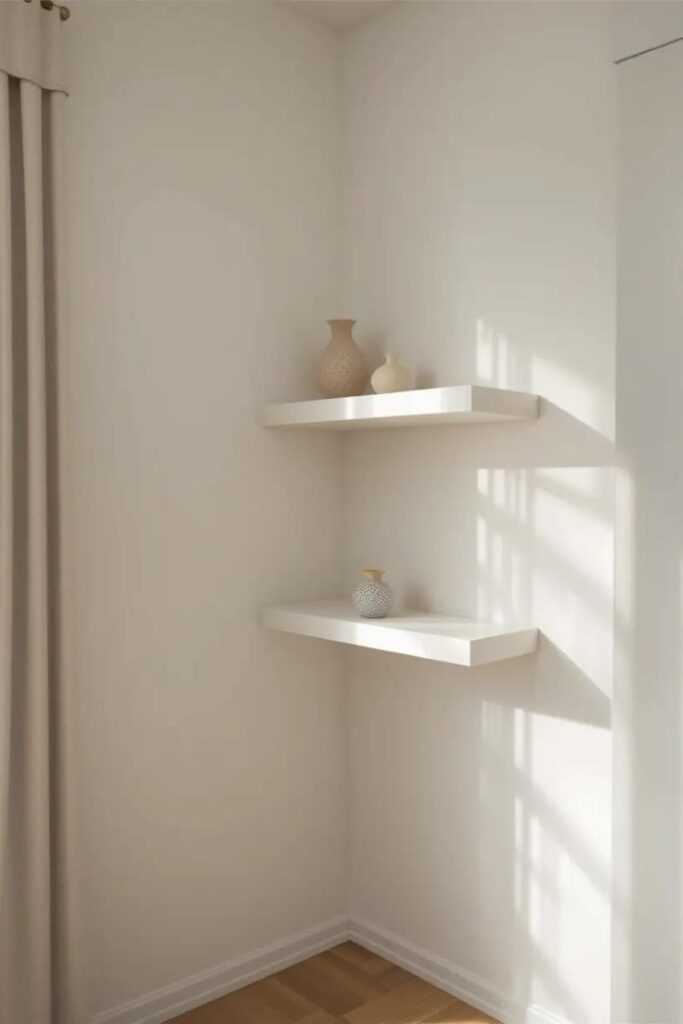
Don’t overlook corners as prime real estate for floating shelving. Corner installations maximize unused space while maintaining the floating effect that minimalists love. Choose shelves that meet precisely at the corner or opt for specially designed corner floating shelves that form a continuous surface.
4. Tonal Display Shelf
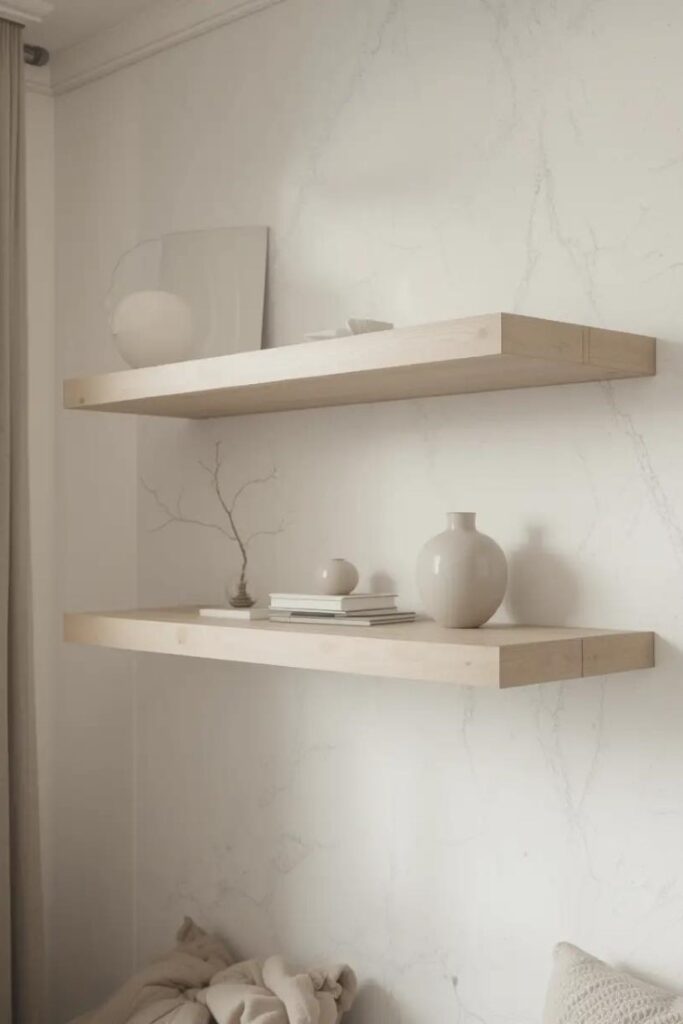
Create a monochromatic moment by selecting items in the same color family for your floating shelves. This approach reduces visual noise while still allowing for personal expression. Limiting your display to a single color palette maintains visual calm while still showcasing your favorite pieces.
5. Books as Art
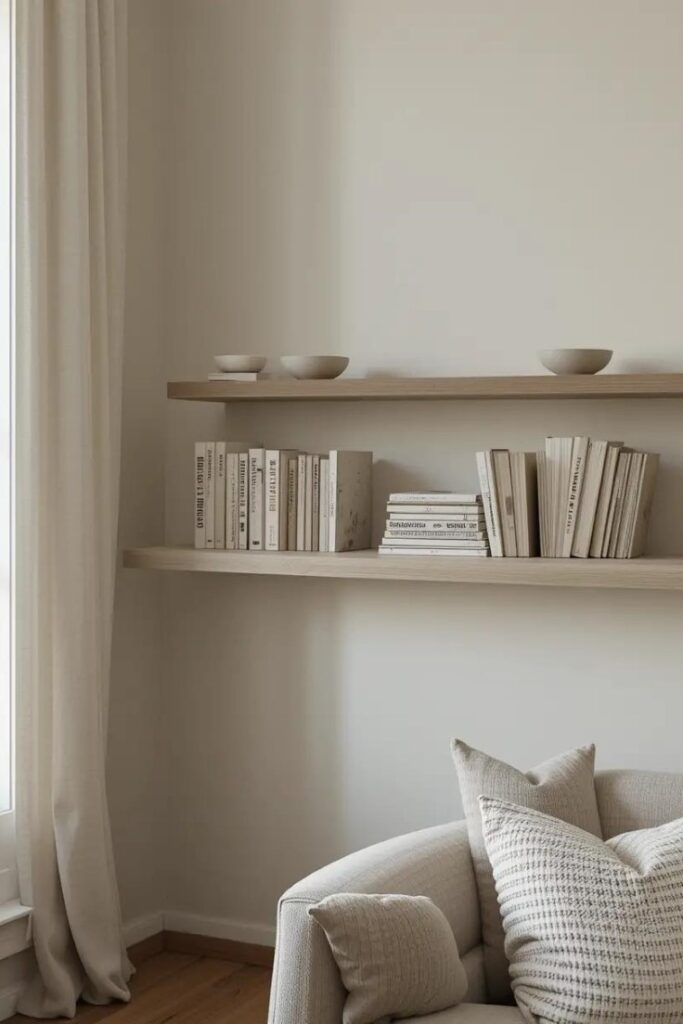
Arrange a small collection of books horizontally on floating shelving, treating them as both functional items and visual elements. Remove dust jackets to reveal simpler book spines or turn books backward to show neutral page edges for an even more minimalist look.
Kitchen Floating Shelves Solutions
6. Open Kitchen Storage
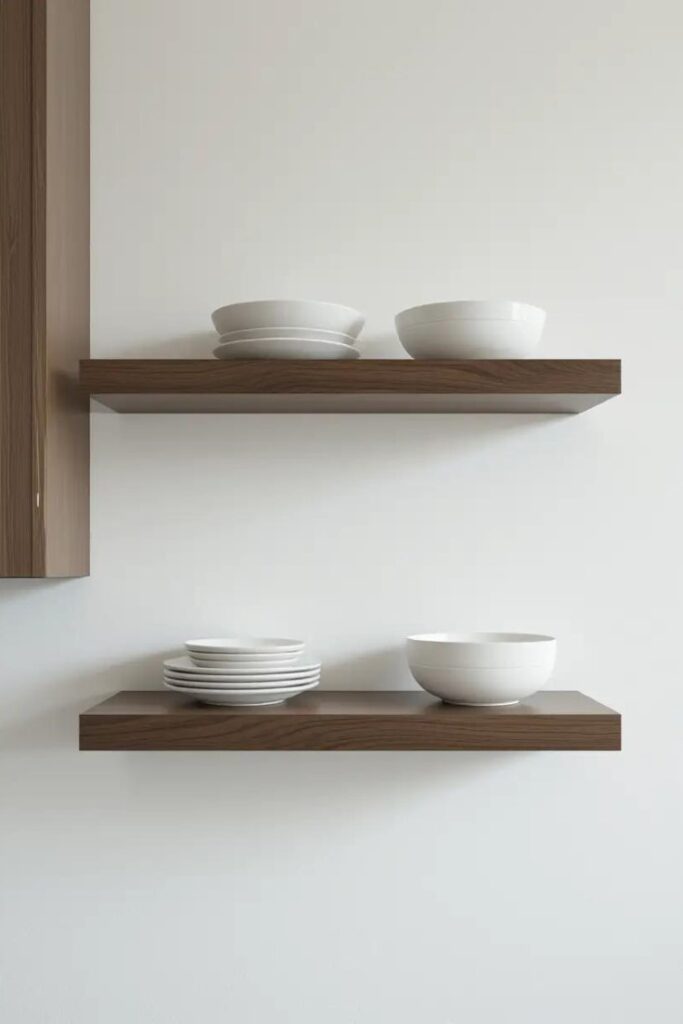
Replace upper cabinets with floating shelves for an open, airy kitchen feel. Floating shelving in kitchens transform everyday necessities into design elements while keeping frequently used items within easy reach. Arrange white dishes or matching containers for a cohesive look.
7. Minimal Coffee Station
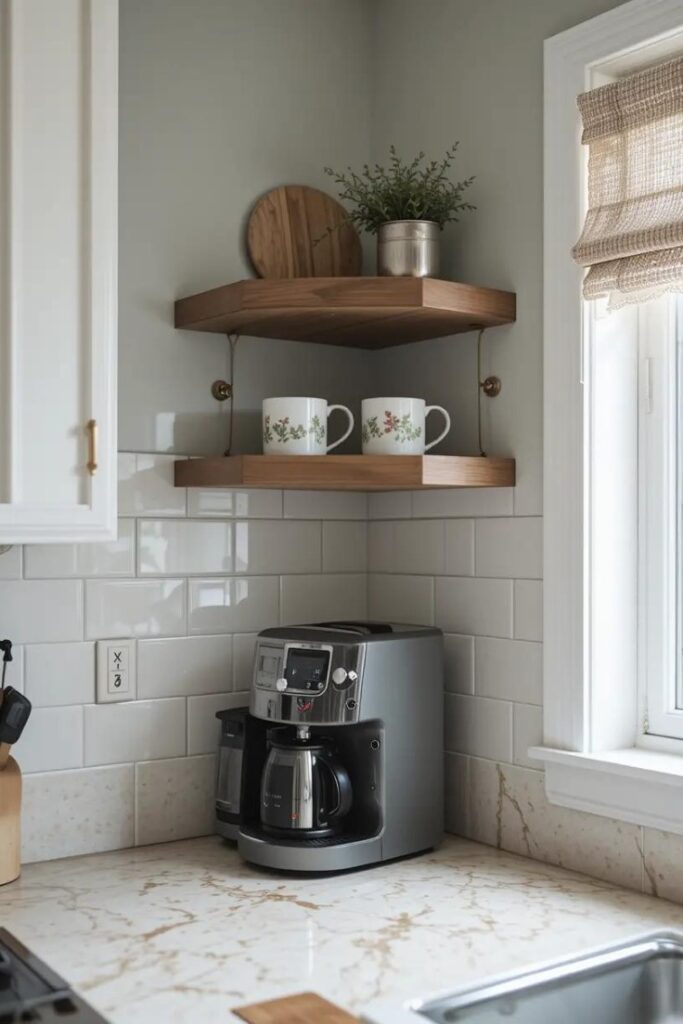
Create a dedicated coffee or tea zone with floating shelves holding only the essentials: a few mugs, a coffee maker, and perhaps a canister of beans or tea. This creates function without fuss—a hallmark of minimalist design.
8. Herb Display Shelf
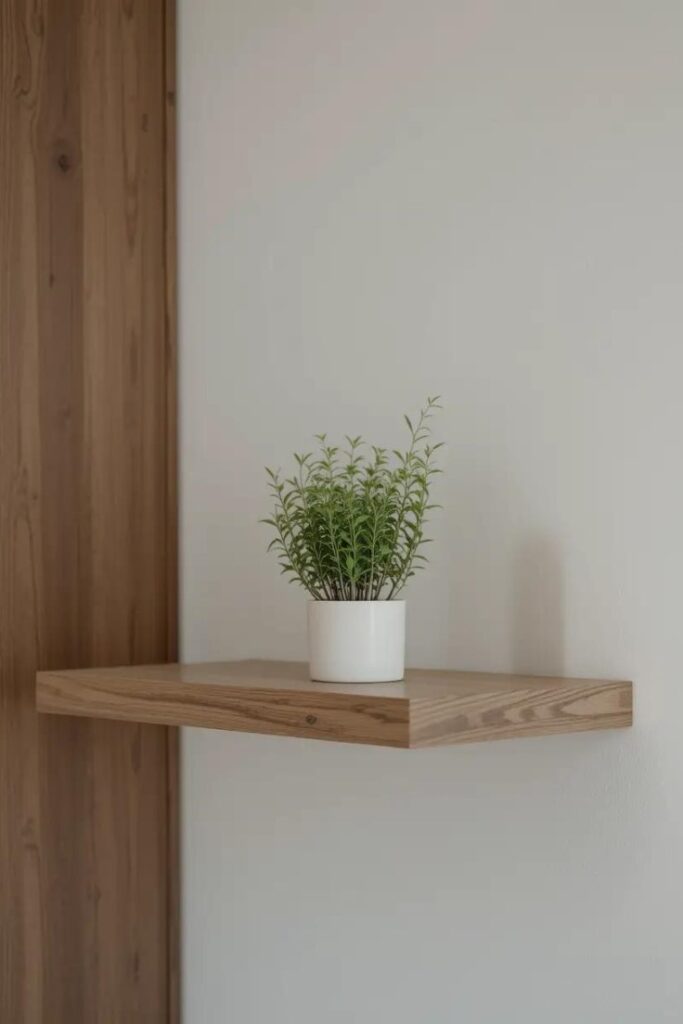
Install a short floating shelf near your cooking area to hold small potted herbs or essential oils. The touch of greenery adds life to your kitchen while remaining purposeful and contained. Select simple pots in white or terracotta to maintain the minimalist aesthetic.
Bedroom Floating Shelves Concepts
9. Bedside Floating Nightstands
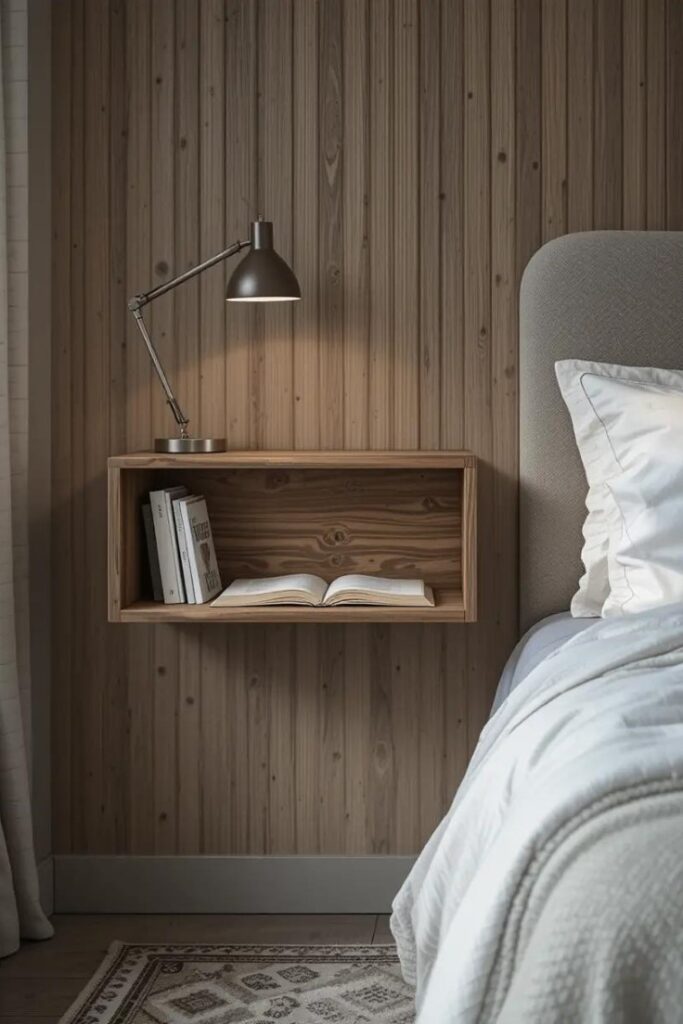
Replace conventional nightstands with floating shelves at bedside height. Floating nightstands free up floor space and enhance the sense of openness, perfect for minimalist bedrooms where tranquility is essential. Include just enough space for a small light, your current book, and perhaps a small plant.
10. Reading Nook Shelf
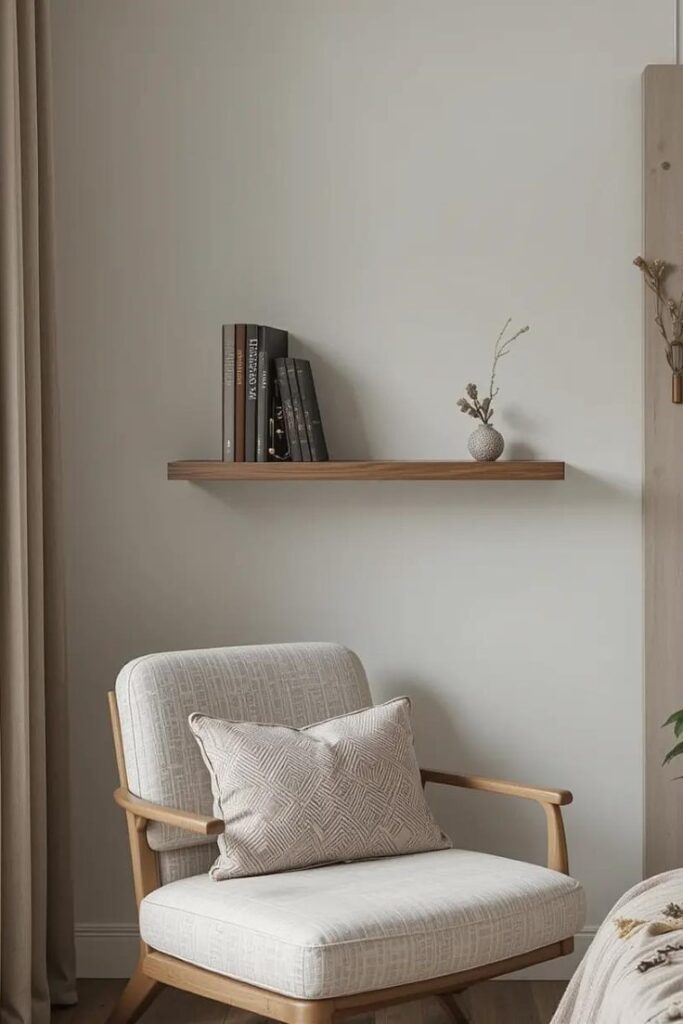
Position a floating shelf near a comfortable chair to create a minimalist reading corner. Include just enough space for a few books, creating a zone dedicated to quiet reflection without excess furniture.
11. Floating Vanity Shelf
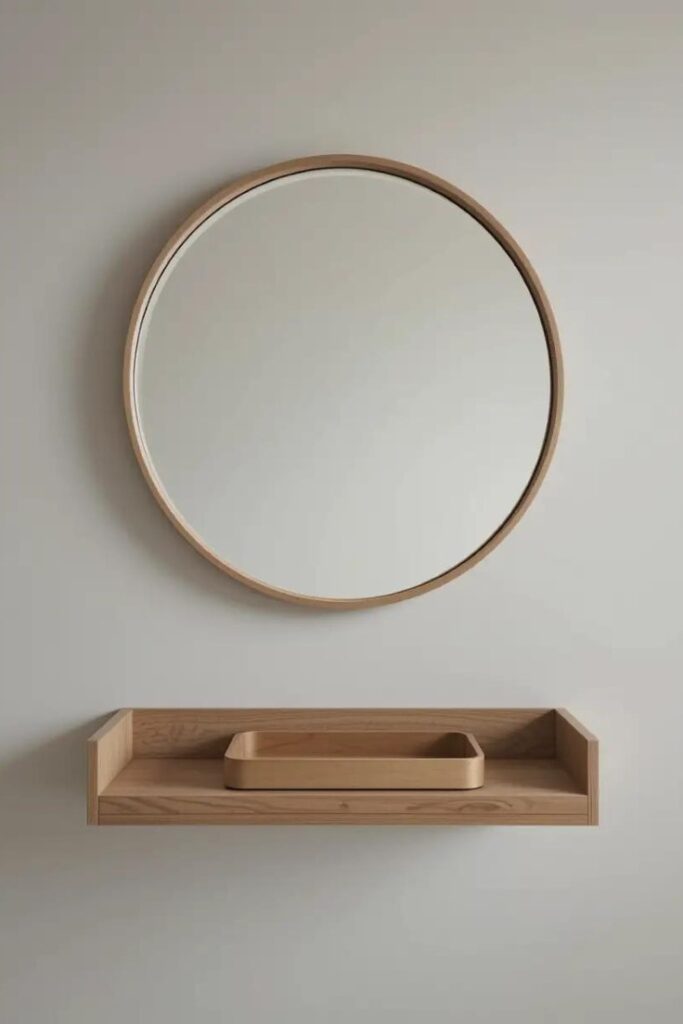
Create a streamlined vanity area with a floating shelf positioned below a wall-mounted mirror. Add only essential items like a jewelry dish and perhaps one decorative element for a clutter-free getting-ready space.
For kitchen ideas, check out 21 Dark Kitchen Ideas for a Bold and Sophisticated Look.
12. Geometric Arrangement
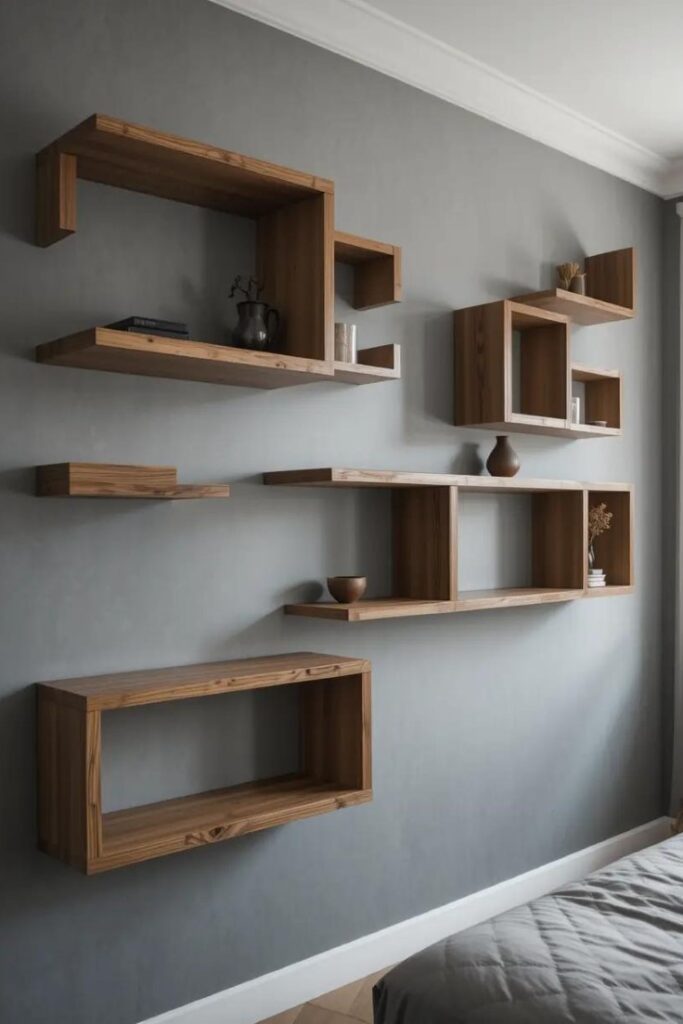
For visual interest that remains minimal, install floating shelves in a geometric pattern like staggered rectangles or an L-shape. Keep the shelves the same depth and material for cohesiveness while playing with length and position.
Bathroom Floating Shelves Ideas
13. Above-Toilet Storage
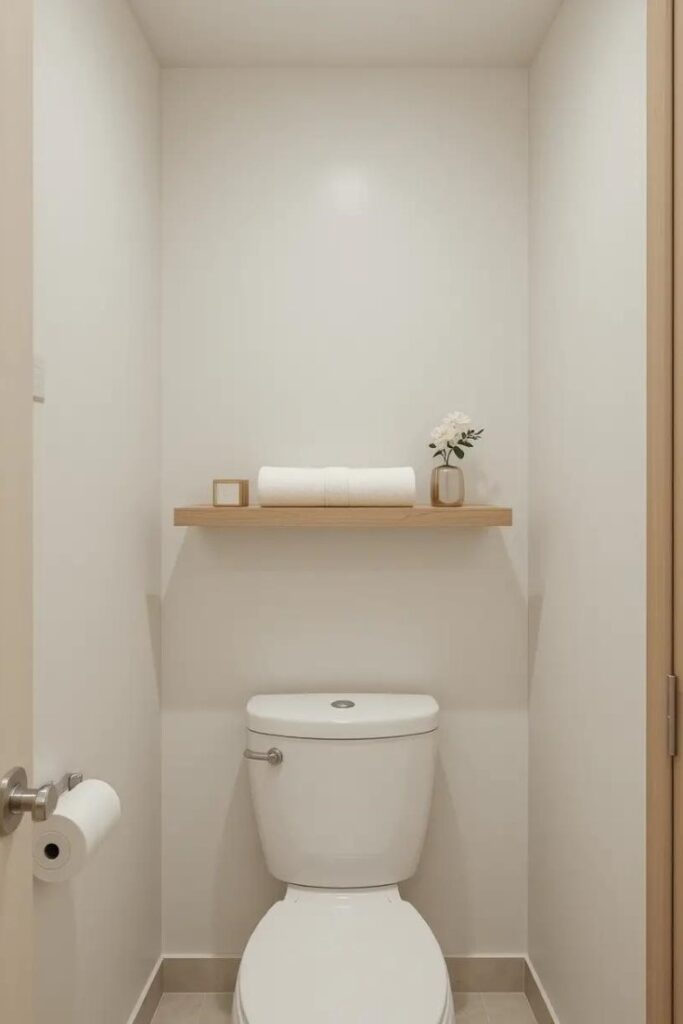
The wall space above the toilet offers perfect placement for floating shelves. In compact bathrooms, this area provides valuable storage without consuming floor space. Floating shelving transform this often-wasted wall area into functional storage that maintains the bathroom’s clean lines.
14. Towel Display Shelf
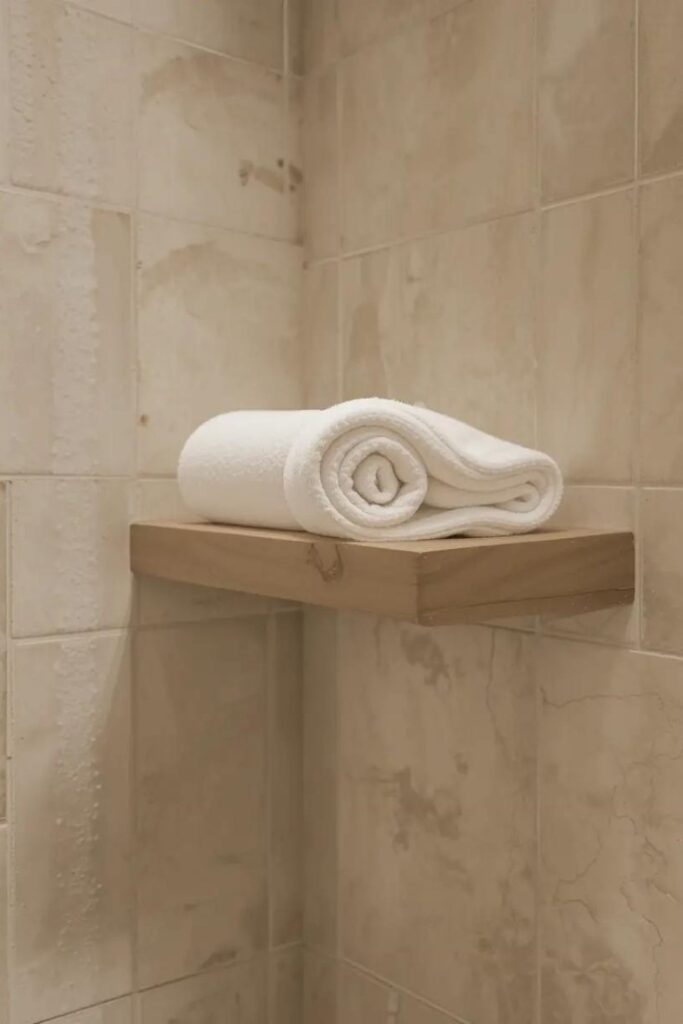
Install a medium-depth floating shelf specifically for rolled towels. This creates both storage and a spa-like display. Stick to white or neutral towels for the most minimalist look.
15. Minimalist Toiletry Storage
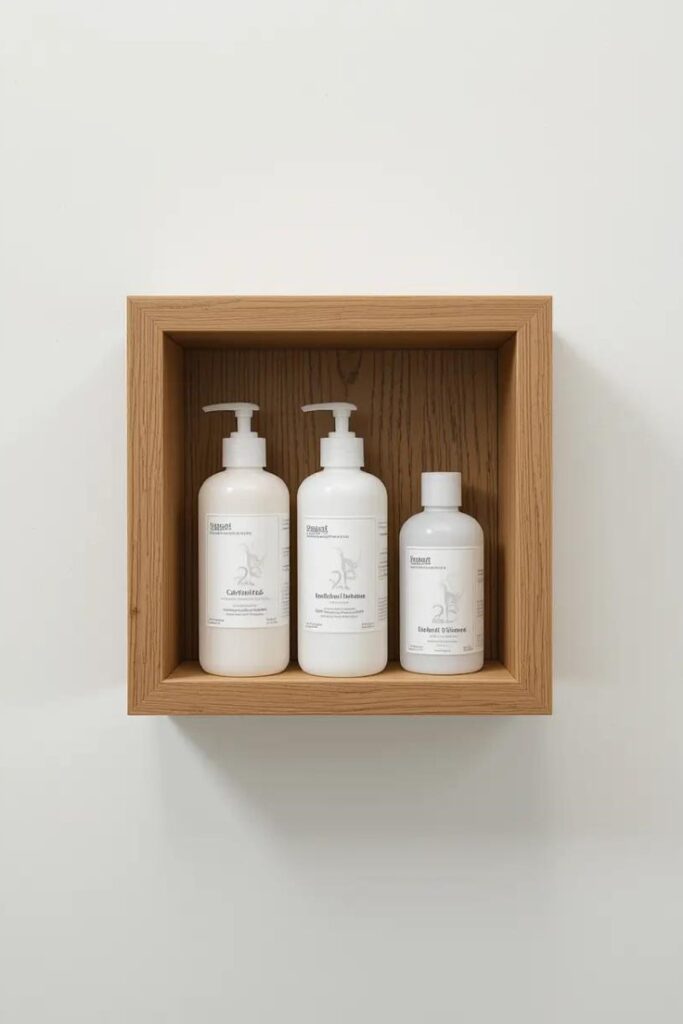
Create a designated space for daily essentials with a floating shelf near the sink. Transfer products into matching containers or select brands with simple packaging that aligns with your aesthetic.
16. Small Plant Ledge
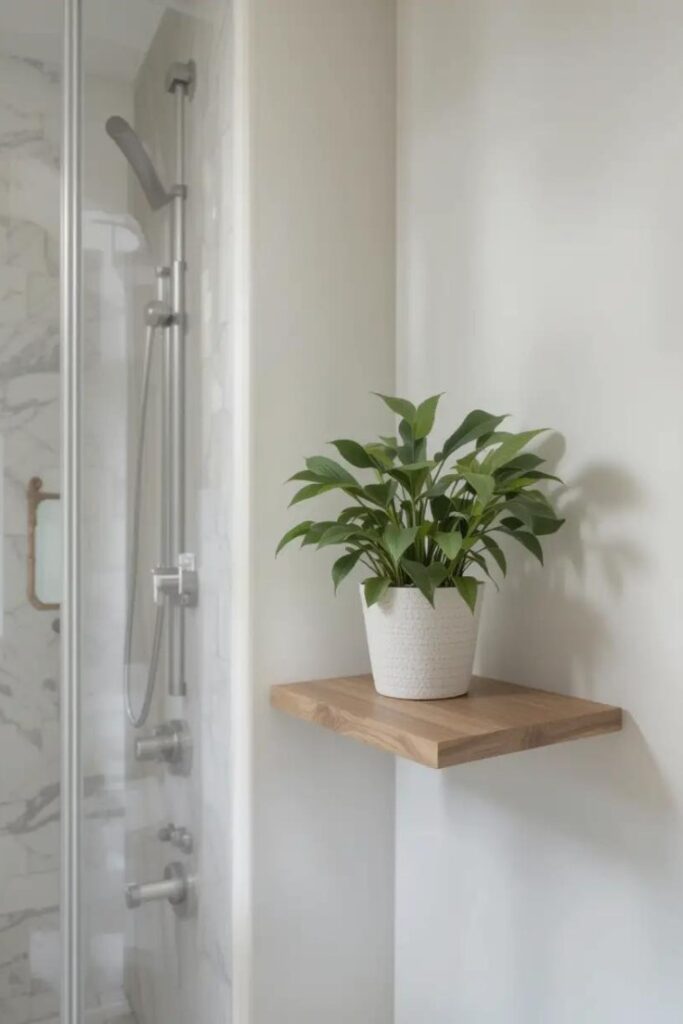
Even in minimalist spaces, plants add welcome life. A narrow floating shelf holding one or two small bathroom-friendly plants adds natural elements without cluttering the space. Plants on floating shelves introduce organic shapes that complement the straight lines of minimalist design.
17. Shower Niche Alternative
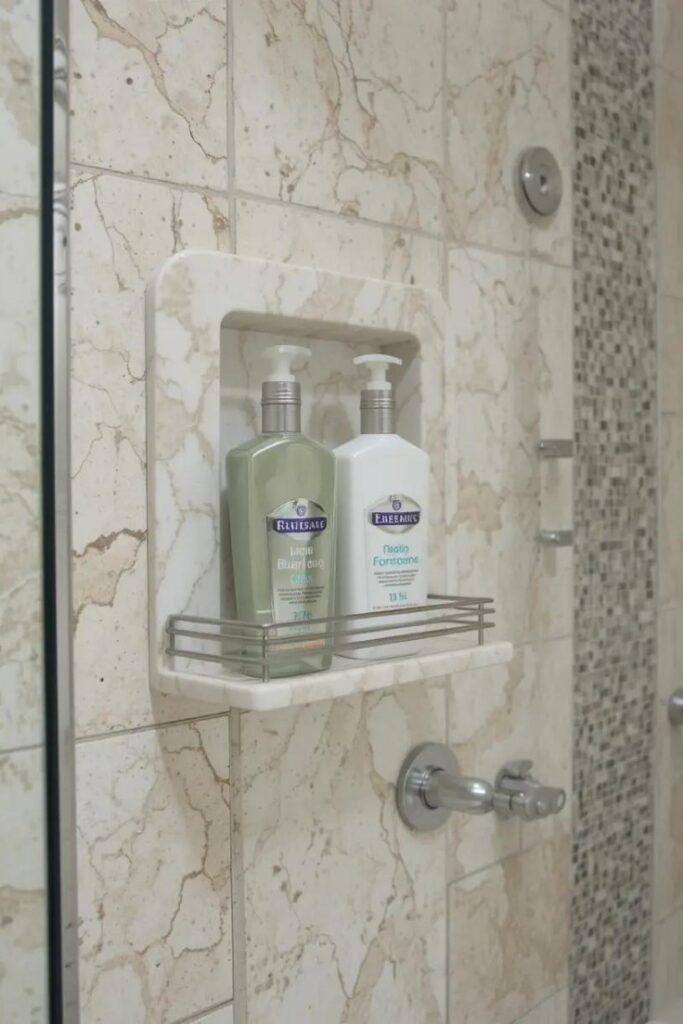
If renovating isn’t an option, floating shelving near the shower can provide similar function to built-in niches. Choose water-resistant materials and include only essential shower products.
Tips for Installing Floating Shelves
For successful floating shelf installation that maintains true minimalist appeal:
- Ensure proper wall anchoring to support the weight without visible brackets.
- Consider the proportions of your wall when determining shelf length.
- Maintain adequate space between shelves for visual breathing room.
- Use a level to achieve perfectly straight installation.
- Select quality materials that won’t sag over time.
Styling Your Floating Shelves the Minimalist Way
Once installed, follow these principles to style your floating shelves while maintaining minimalist integrity:
- Practice the “one in, one out” rule—when adding a new item, remove another.
- Leave plenty of negative space around objects.
- Group similar items together rather than scattering them.
- Choose quality over quantity for displayed items.
- Edit your displays seasonally to keep only what feels current and necessary.
Conclusion
Floating shelves offer the perfect marriage of form and function for minimalist spaces. By implementing these 17 ideas throughout your home, you’ll create storage solutions that feel intentional and aligned with minimalist principles. The beauty of floating shelves lies in their versatility—they can transform any room while maintaining the clean, uncluttered aesthetic that makes minimalist design so appealing.
Remember that true minimalism isn’t about emptiness but about purpose. Each floating shelf should serve a specific function while contributing to your home’s overall sense of calm and intention.
Frequently Asked Questions
How much weight can floating shelves hold?
The weight capacity of floating shelves depends on the installation method and materials used. Standard floating shelves properly installed with the right hardware can typically support between 25-75 pounds. For heavier loads, look for shelving systems with concealed brackets that extend fully into the shelf and secure to wall studs. Always check manufacturer specifications and ensure proper installation into wall studs or using appropriate anchors.
What’s the best material for minimalist floating shelves?
For minimalist floating shelves, solid wood, engineered wood, and metal are popular choices. Solid wood offers natural warmth and durability, making it ideal for minimalist spaces where each element should feel intentional. White or black laminate provides a clean, modern look that disappears into the wall. Metal shelves in matte finishes offer industrial minimalism. Consider your room’s existing materials and choose something complementary but not too busy.
How far apart should I space multiple floating shelving?
For a minimalist look, spacing between floating shelves typically ranges from 12-18 inches, depending on what you’ll display. Allow enough space between shelves so items don’t feel crowded, maintaining the open, breathing room that minimalist design requires. Consider the height of objects you’ll place on each shelf, plus 3-5 additional inches. In areas like kitchens where function is primary, you might position shelves closer together (8-12 inches) while maintaining visual balance.
How do I install floating shelves without visible brackets?
True floating shelves use concealed mounting systems where metal rods embedded in the wall slide into corresponding holes in the shelf. For DIY installation, you’ll need to: 1) Locate and mark wall studs, 2) Install the bracket system into studs or using proper wall anchors, 3) Drill precisely positioned holes in the shelf backing, and 4) Slide the shelf onto the mounted hardware. For the cleanest minimalist look, ensure the shelf fits snugly against the wall with no gap.
How do I prevent my floating shelves from sagging over time?
To prevent sagging in floating shelving: 1) Choose appropriate materials—solid hardwoods or thick plywood core shelves resist bending, 2) Install proper support—ensure mounting hardware extends at least two-thirds the depth of the shelf, 3) Distribute weight evenly across the shelf rather than concentrating it at the front edge, and 4) Limit shelf length—for standard materials, keep spans under 36 inches or add additional concealed support. Quality materials and proper installation are worth the investment for floating shelving that maintain their minimalist appeal over time.

